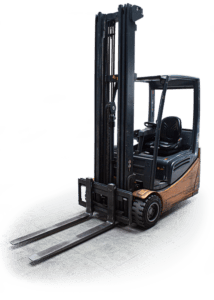Toolbox Topic: Forklift Safety
If you drive a forklift at work, it may be one of the most dangerous things you do all day. In this episode, I have several tips for those of you who are just starting as forklift drivers and good reminders for those who have been doing it a long time.
Forklift Definitions
Forklifts fall under the OSHA standard 1910.178 powered industrial trucks or PITS. Powered industrial trucks are material handling equipment powered by electric motors or an internal combustion engine. Types of PITs include hand trucks, platform lift trucks, tractors, and fork trucks. The standard excludes farm vehicles, nonflammable compressed gas or compressed air industrial trucks, or vehicles intended primarily for earth moving or over the road operations.
It may be simpler to give a few examples: PITs can include forklifts, stock pickers, telehandlers, or reach trucks. The standard covers most powered material handling equipment designed for horizontal movement.

Forklift History
The fork truck, which evolved into the forklift, has been around for nearly 100 years. The evolution of the forklift happened slowly, over many decades.
In 1906, the Pennsylvania Railroad Company invented an early version of the forklift. It was a battery-powered platform truck used to move luggage.
The Clark Company created a machine called the Trucktactor in 1917 to move materials around their axle plant. The Truckractor was a cart with an elevating wooden platform. After some visitors showed interest, the company decided to manufacture units for sale.
In 1923, Yale & Towne Manufacturing introduced the first lift to incorporate two forks and an extending mast.
In The 1930s, standardized pallet sizes became the norm. This little innovation led to improved shipping times.
In 1954, Lansing Bagnall designed a forklift with forks that could move side to side and up and down. Now, forklifts could not only navigate narrow aisles but lift objects much higher. This marked the beginning of modern warehousing.
In the 1950’s and 60’s, new safety features included fork backrests to stabilize loads and cages to protect drivers from falling objects.
In the 1980s, driver comfort and ergonomics improved safety and increased productivity.
Today’s forklift manufacturers continue to innovate. Some high-tech versions include Hydrogen-powered, low-emission forklifts and even “intelligent” forklifts directly connected to inventory management systems. There are more than a million forklifts in use worldwide.
https://liftow.com/blogs/news/history-of-the-forklift-how-well-do-you-know-it
https://www.sunbeltrentals.com/blog/evolution-of-the-forklift/
Forklift Safety Statistics
Of the nearly 8000 forklift injuries in 2018, 88 percent were men, and 12 percent were women. [BLS] That same year, men accounted for 99% of Forklift-related fatalities.
Operators ages 25 to 34 accounted for 1,700 forklift-related injuries in 2018, making it the group with the highest injury rates.
Warehouses, transportation, and utilities had the highest injury total over any other industry in 2018; that total reached 5,390 incidents. [BLS]
In 2018, the three leading injuries from forklift accidents were fractures (1,710), bruises contusions (1,570), and sprains/muscle tears (1,490). [BLS]
Forklift overturns are still the #1 way to die using a forklift. [OSHA]
https://www.bigrentz.com/blog/forklift-statistics
https://www.bls.gov/iif/data.htm
Forklift Safety Tips
Safety Tip#1
Always operate the lift according to the manufacturer’s instructions. Always wear your seatbelt. Never exceed the load rating. Ensure the load is stable and balanced and never raise or lower the load while traveling.
Safety Tip#2
Keep a safe distance from platforms, loading docks, and ramp edges. Always inspect trailers and loading ramps. If damaged, don’t drive over them and report it to the appropriate person.
Safety Tip #3
Use your horn to alert other operators and pedestrians. This isn’t the county fair, no giving out rides. Never use the forks to lift people, not even on a pallet. Only operate a forklift if you are trained and certified.
Safety Tip #4
Driving a forklift is very different from driving a car. The major difference between a forklift and a car is stability. A car uses a four-point suspension system, but almost all forklifts use a three-point suspension system. This design allows the center of gravity to shift but, at the same time, increases the risk of tip over.
Safety Tip #5
Inspections allow operators to discover problems before accidents can happen. Always perform an inspection and never operate a forklift that does not pass inspection.
Visual inspections should include a complete “walk-around” of the equipment. Look for any evidence of leaks, missing parts, or damage. Check the following:
- Hydraulic system – Confirm these items are working correctly: lift/lower, side shift, tilt, and reach functions.
- Tires – Visually inspect and move the equipment a small distance.
- Forward/Reverse Function – Move the equipment forward and in reverse.
- Horn – Verify that the horn is operating. A soft or muted horn should fail inspection.
- Neutral start – Turn on the equipment and verify it does not move on its own.
- Steering mechanism – Verify that the equipment turns correctly and without excessive “play” in the steering control.
- Lights – Check for the proper operation of all lights.
- Brakes – Verify that the brakes function correctly. The brakes should stop the machine within 1½ times the length of the equipment.
- Data Plate: Verify that the equipment data plate is intact and legible. Check the data plate for the lifting capacity and operational limits.
- Safety Equipment: Inspect and wear all required personal protection equipment (PPE) such as harnesses, tethers, belts, etc.